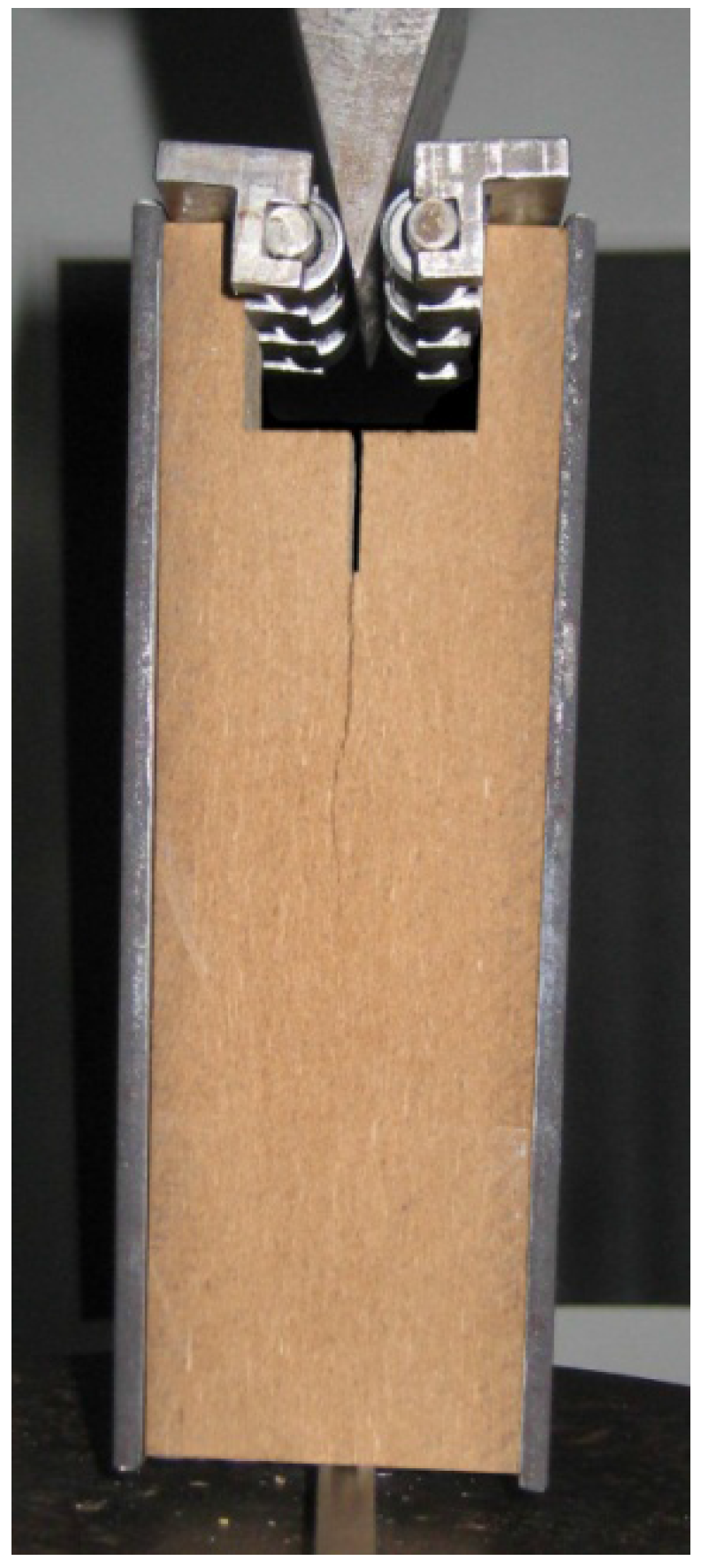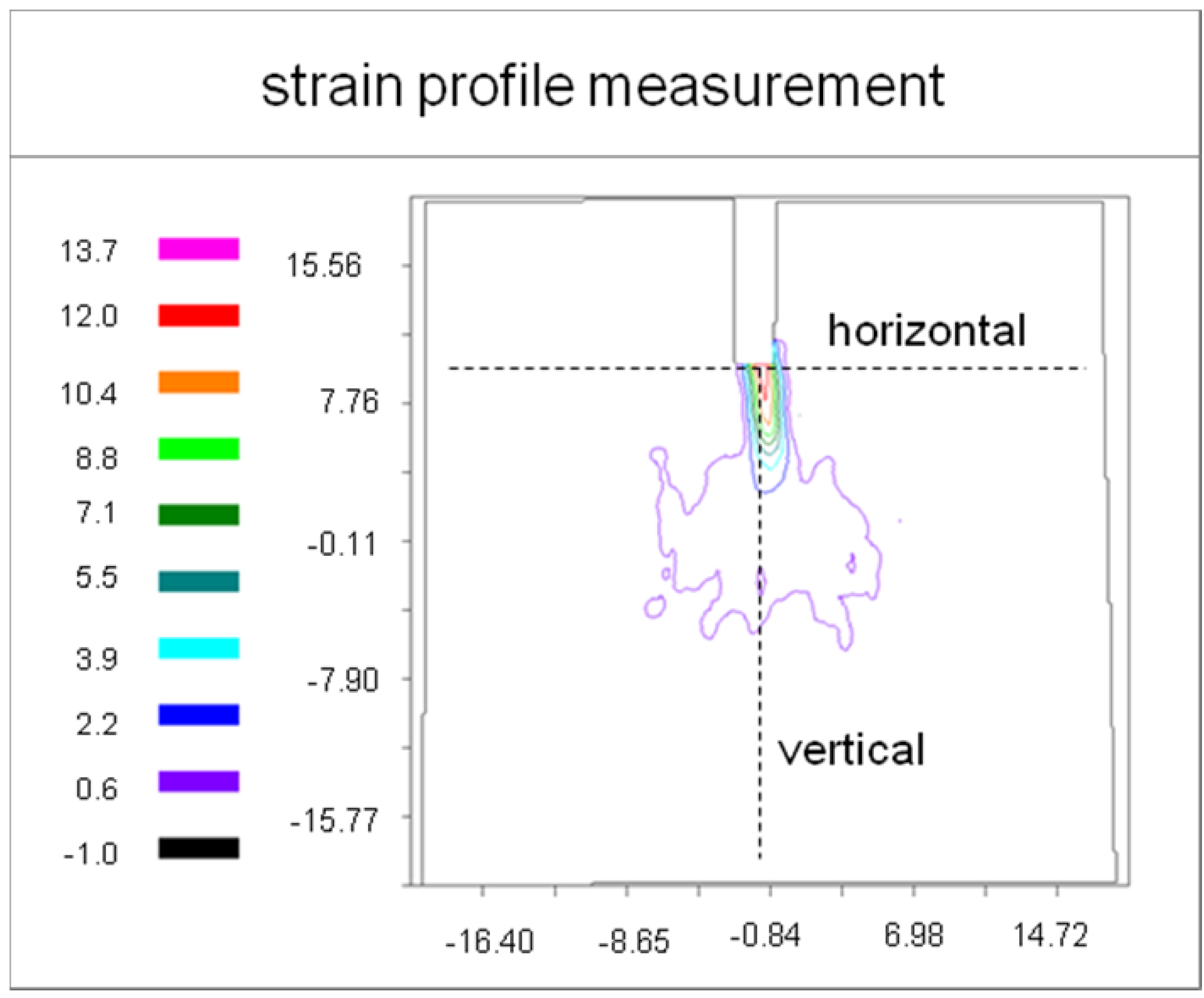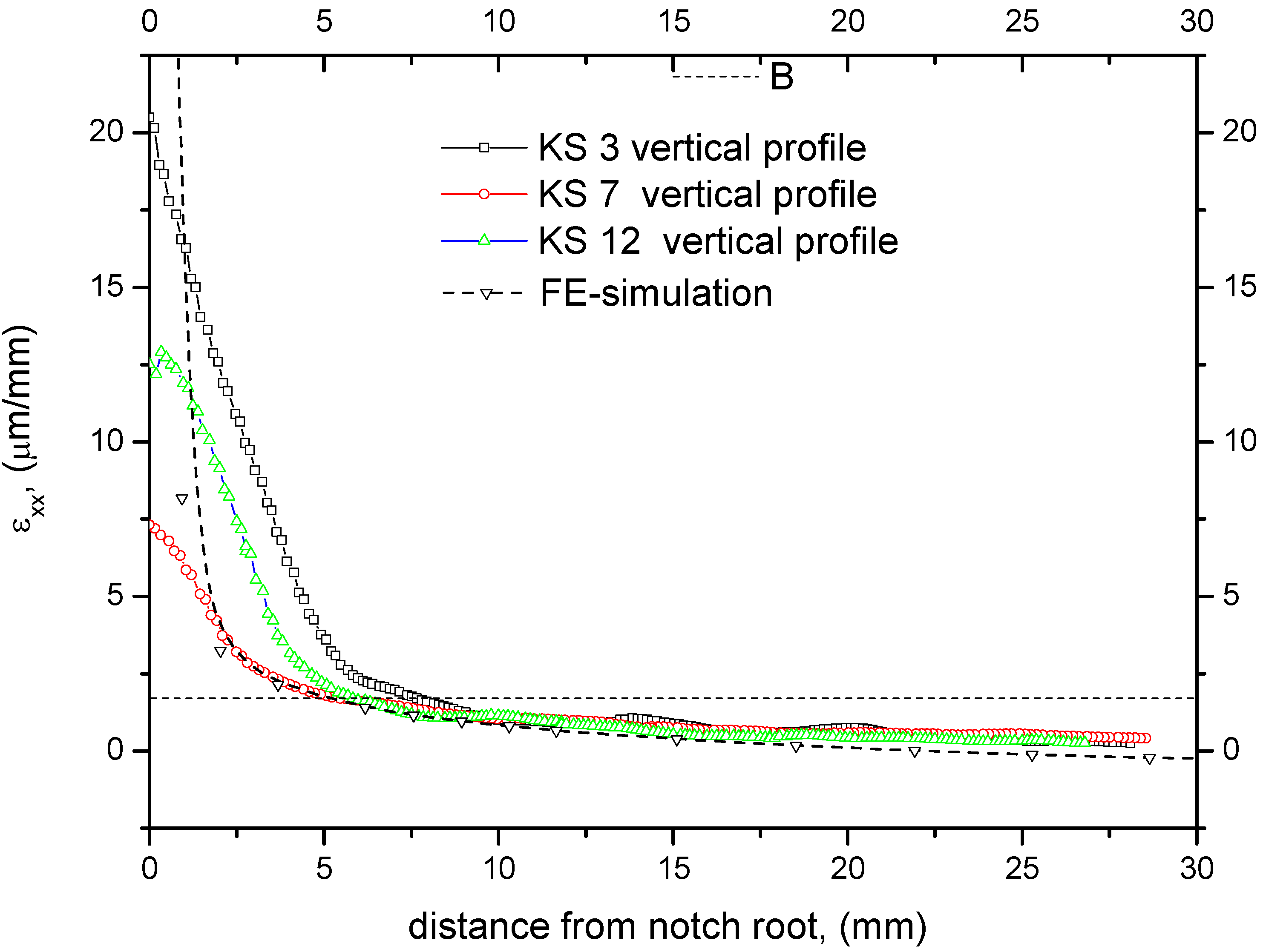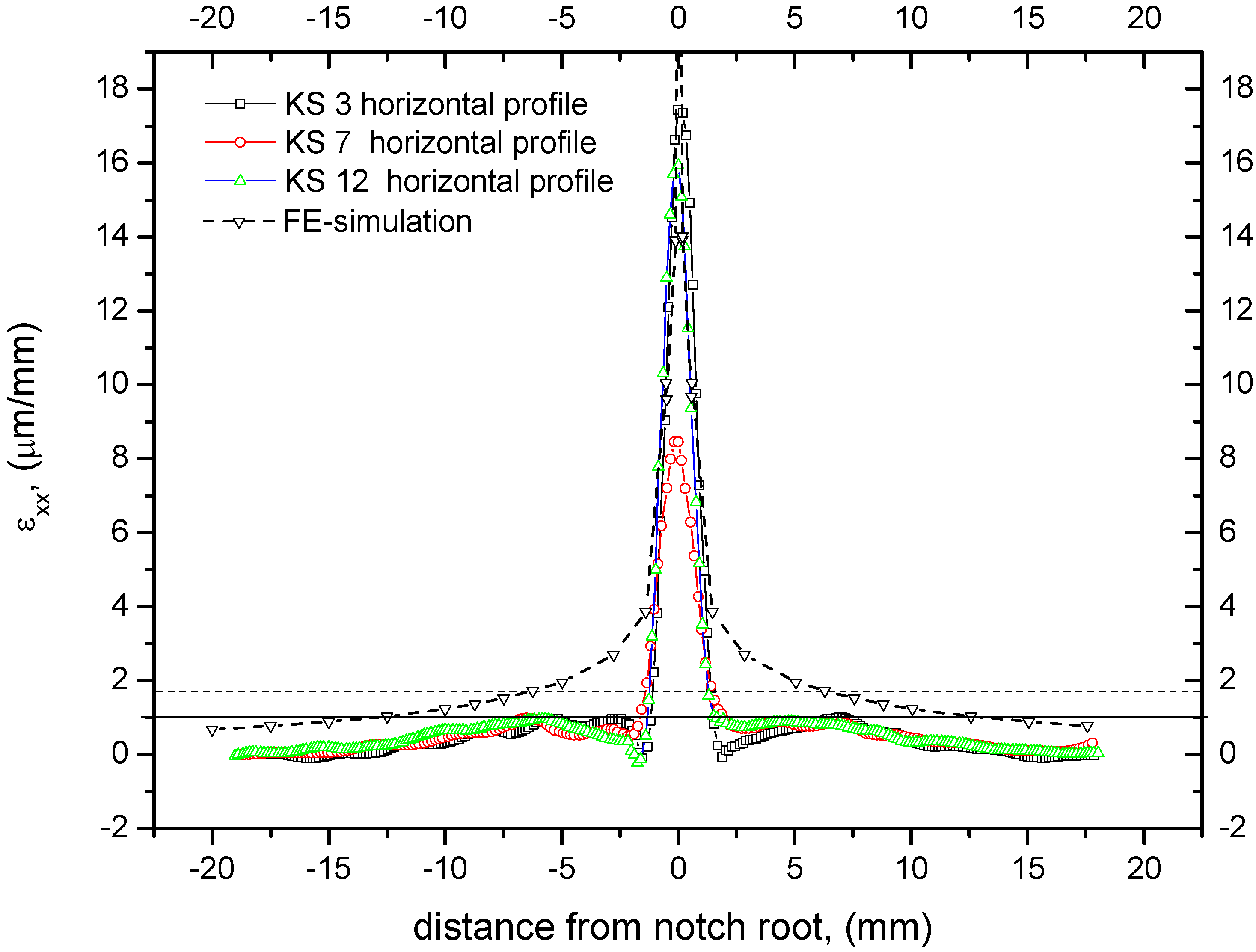Strain Measurements within Fibre Boards. Part II: Strain Concentrations at the Crack Tip of MDF Specimens Tested by the Wedge Splitting Method
Abstract
:1. Introduction

2. Experimental Section
2.1. Specific Fracture Energy
2.2. Stress Intensity Factor
2.3. Speckle Measurement

3. Results and Discussion
3.1. Specific Fracture Energy
| Panel | GC1 (J/m2) | Slope1 (J/m3) | Gf2 (J/m2) |
|---|---|---|---|
| 609 kg/m3 (19 mm) | 48,2 | 296 | 61,52 |
| 737 kg/m3 (19 mm) | 48,4 | 303 | 62,04 |
3.2. Stress Intensity Factor
| Density, (kg/m3) | Gc, (J/m2) | E, (MPa) | ν, (-) | KIC, (MPam0.5) | |
|---|---|---|---|---|---|
| MDF 38 | 609 | 59 | 90 | 0.33 | 0.077 |
| MDF 46 | 737 | 48 | 200 | 0.33 | 0.104 |
3.3. ESPI Measurement




| Specimen | Process zone length in crack forward direction from vertical profiles in (mm); Method 1 | Process zone width in (mm) from horizontal profiles; Method 1 | Process zone width in (mm) from horizontal profiles; Method 2 |
|---|---|---|---|
| 1 (KS 3) | 7.66 | 2.44 | 6.23 |
| 2 (KS 7) | 5.47 | 2.75 | 6.58 |
| 3 (KS 12) | 5.83 | 2.57 | 6.12 |
4. Conclusions
Acknowledgments
References
- European Committee for Standardization. Particleboards and Fiberboards—Determination Of Tensile Strength Perpendicular to the Plane of the Board CSN EN 319; Österreichisches Normungsinstitut: Vienna, Austria, 1993. [Google Scholar]
- European Committee for Standardization. Wood-Based-Panels—Determination of Modulus of Elasticity in Bending and of Bending Strength CSN EN 310; Österreichisches Normungsinstitut: Vienna, Austria, 1993. [Google Scholar]
- Tschegg, E.K. Prüfeinrichtung zur Ermittlung von Bruchmechanischen Kennwerten sowie hierfür geeignete Prüfkörper. Austria Patent 3,903,28B, 31 January 1986. [Google Scholar]
- Tschegg, E.K. New equipments for fracture tests on concrete. Materialprüfung 1991, 33, 5189–5194. [Google Scholar]
- Stanzl-Tschegg, S.E.; Tan, D.M.; Tschegg, E.K. New splitting method for wood fracture characterization. Wood Sci. Technol. 1995, 29, 31–50. [Google Scholar] [CrossRef]
- Ehart, R.J.A.; Stanzl-Tschegg, S.E.; Tschegg, E.K. Fracture characteristics of PARALLAM (R) PSL in comparison to solid wood and particleboard. Wood Sci. Technol. 1998, 32, 43–55. [Google Scholar] [CrossRef]
- Ehart, R.J.A.; Stanzl-Tschegg, S.E.; Tschegg, E.K. Characterization of crack propagation in particleboard. Wood Sci. Technol. 1996, 30, 307–321. [Google Scholar] [CrossRef]
- Ehart, R.J.A.; Stanzl-Tschegg, S.E.; Tschegg, E.K. Fracture mechanics in particleboard–experiments and FE simulations. In Proceedings of the 2nd International Conference On the Development of Wood Science, Technology and Forestry (ICWSF 96), Sopron, Hungary, 10–12 April 1996.
- Sinn, G.; Beer, P.; Gindl, M.; Stanzl-Tschegg, S. Wedge splitting experiments on three-layered particleboard and consequences for cutting. Holz Roh Werkstoff 2008, 66, 135–141. [Google Scholar] [CrossRef]
- Matsumoto, N.; Nairn, J.A. The fracture toughness of medium density fiberboard (MDF) including the effects of fiber bridging and crack-plane interference. Eng. Fract. Mech. 2009, 76, 2748–2757. [Google Scholar] [CrossRef]
- Yoshihara, H. Mode I and mode II initiation fracture toughness and resistance curve of medium density fiberboard measured by double cantilever beam and three-point bend end-notched flexure tests. Eng. Fract. Mech. 2010, 77, 2537–2549. [Google Scholar] [CrossRef]
- Harmuth, H. Stability of Crack-Propagation Associated with Fracture Energy Determined by Wedge Splitting Specimen. Theor. Appl. Fract. Mech. 1995, 23, 103–108. [Google Scholar] [CrossRef]
- Müller, U.; Sretenovic, A.; Vincenti, A.; Gindl, W. Direct measurement of strain distribution along a wood bond line. Part 1: Shear strain concentration in a lap joint specimen by means of electronic speckle pattern interferometry. Holzforschung 2005, 59, 300–306. [Google Scholar]
- Frühmann, K.; Reiterer, A.; Tschegg, E.K.; Stanzl-Tschegg, S.S. Fracture characteristics of wood under mode I, mode II, and mode III loading. Phil. Mag. A 2002, 82, 3289–3298. [Google Scholar] [CrossRef]
- Reiterer, A. The influence of temperature on the mode I fracture behavior of wood. J. Mater. Sci. Lett. 2001, 20, 1905–1907. [Google Scholar] [CrossRef]
- Reiterer, A.; Sinn, G.; Stanzl-Tschegg, S.E. Fracture characteristics of different wood species under mode I loading perpendicular to the grain. Mater. Sci. Eng. A 2002, 332, 29–36. [Google Scholar] [CrossRef]
- Reiterer, A.; Stanzl-Tschegg, S.E.; Tschegg, E.K. Mode I fracture and acoustic emission of softwood and hardwood. Wood Sci. Technol. 2000, 34, 417–430. [Google Scholar] [CrossRef]
- Reiterer, A.; Tschegg, S. The influence of moisture content on the mode I fracture behaviour of sprucewood. J. Mater. Sci. 2002, 37, 4487–4491. [Google Scholar]
- Tan, D.M.; Stanzltschegg, S.E.; Tschegg, E.K. Models of Wood Fracture in Mode-I and Mode-Ii. Holz Roh Werkstoff 1995, 53, 159–164. [Google Scholar] [CrossRef]
- Tschegg, E.K.; Bohner, E.; Tritthart, J.; Müller, H.S. Investigations into fracture of carbonated concrete. Mag. Concr. Res. 2011, 63, 21–30. [Google Scholar] [CrossRef]
- Tschegg, E.K.; Fendt, K.T.; Manhart, Ch.; Harmuth, H. Uniaxial and biaxial fracture behaviour of refractory materials. Eng. Fract. Mech. 2009, 76, 2249–2259. [Google Scholar] [CrossRef]
- Tschegg, E.K.; Jamek, M.; Lugmayr, R. Fatigue crack growth in asphalt and asphalt-interfaces. Eng. Fract. Mech. 2011, 78, 1044–1054. [Google Scholar] [CrossRef]
- Niemz, P.; Diener, M. Vergleichende Untersuchungen zur Ermittlung der Bruchzähigkeit an Holzwerkstoffen. Eur. J. Wood Wood Prod. 1999, 57, 222–224. [Google Scholar]
- Niemz, P.; Diener, M.; Pöhler, E. Untersuchungen zur Ermittlung der Bruchzähigkeit and MDF-Platten. Eur. J. Wood Wood Prod. 1997, 55, 327–330. [Google Scholar]
- Schachner, H.; Reiterer, A.; Stanzl-Tschegg, S.E. Orthotropic fracture toughness of wood. J. Mater. Sci. Lett. 2000, 19, 1783–1785. [Google Scholar] [CrossRef]
- Henshell, R.D.; Shaw, K.G. Crack Tip Finite Elements Are Unnecessary. Int. J. Numer. Methods Eng. 1975, 9, 495–507. [Google Scholar] [CrossRef]
- Eberhardsteiner, J. Biaxial testing of orthotropic materials using electronic speckle pattern interferometry. Measurement 1995, 16, 139–148. [Google Scholar] [CrossRef]
- Rastogi, P.K. Measurement of static surface displacements, derivatives of displacements, and three-dimensional surface shapes—Examples of applications to non-destructive testing. In Digital Speckle Pattern Interferometry and Related Techniques; Rastogi, P.K., Ed.; John Wiley & Sons: Chichester, UK, 2000; pp. 141–224. [Google Scholar]
- Eberhardsteiner, J. Mechanisches Verhalten von Fichtenholz: Experimentelle Bestimmung der biaxialen Festigkeitseigenschaften; Springer: Vienna, Austria, 2002. [Google Scholar]
- Mohan, N.K.; Rastogi, P. Recent developments in digital speckle pattern interferometry. Opt. Lasers Eng. 2003, 40, 439–445. [Google Scholar] [CrossRef]
- Rathke, J.; Sinn, G.; Konnerth, J.; Müller, U. Strain measurements within fiber boards. Part I: Inhomogeneous strain distribution within medium density fiberboards (MDF) loaded perpendicularly to the plane of the board. Materials 2012, 5, 1115–1124. [Google Scholar]
- Matsumoto, N.; Nairn, J.A. Fracture Toughness of Wood and Wood Composites during Crack Propagation. Wood Fiber Sci. 2012, 44, 121–133. [Google Scholar]
- Anderson, T.L. Linear Elastic Fracture Mechanics. In Fracture Mechanics. Fundamentals and Applications; CRC Press: Boca Raton, FL, USA, 1995; pp. 31–96. [Google Scholar]
© 2012 by the authors; licensee MDPI, Basel, Switzerland. This article is an open access article distributed under the terms and conditions of the Creative Commons Attribution license (http://creativecommons.org/licenses/by/3.0/).
Share and Cite
Sinn, G.; Müller, U.; Konnerth, J.; Rathke, J. Strain Measurements within Fibre Boards. Part II: Strain Concentrations at the Crack Tip of MDF Specimens Tested by the Wedge Splitting Method. Materials 2012, 5, 1495-1507. https://doi.org/10.3390/ma5081495
Sinn G, Müller U, Konnerth J, Rathke J. Strain Measurements within Fibre Boards. Part II: Strain Concentrations at the Crack Tip of MDF Specimens Tested by the Wedge Splitting Method. Materials. 2012; 5(8):1495-1507. https://doi.org/10.3390/ma5081495
Chicago/Turabian StyleSinn, Gerhard, Ulrich Müller, Johannes Konnerth, and Jörn Rathke. 2012. "Strain Measurements within Fibre Boards. Part II: Strain Concentrations at the Crack Tip of MDF Specimens Tested by the Wedge Splitting Method" Materials 5, no. 8: 1495-1507. https://doi.org/10.3390/ma5081495
APA StyleSinn, G., Müller, U., Konnerth, J., & Rathke, J. (2012). Strain Measurements within Fibre Boards. Part II: Strain Concentrations at the Crack Tip of MDF Specimens Tested by the Wedge Splitting Method. Materials, 5(8), 1495-1507. https://doi.org/10.3390/ma5081495





